| << Previous | Contents | Next >> |
Geotechnical Aspects of Pavements Reference Manual
Chapter 8.0 Construction And Design Verification For Unbound Pavement Materials
8.1 Introduction
Thus far, this reference manual has described the processes detailing the pre-construction phase - site characterization and design. The last phase of work required to complete a roadway, the construction phase, is the emphasis of this chapter. As such, construction specifications are described, quality control/quality assurance concepts are reviewed, and innovative measures of design verification are provided. Issues surrounding the preparation of the pavement foundation, focused primarily upon cut and fill soil construction, prepared subgrade, chemically stabilized soils, and unbound engineered aggregate layers (base/subbase) are detailed. Lastly, a review of monitoring techniques for the finished product is provided, an important consideration with the current move toward performance specifications and warranties.
Projects come in all shapes and sizes, each presenting unique challenges. For instance, a new roadway alignment could be conceptualized in a flat topography, requiring little earthwork, or conversely, in a hilly or mountainous topography that requires large cuts - excavation and/or rock blasting - and placement of deep fills. In either case, the engineer typically must make do with the local soils and design for the site conditions encountered. Fundamental to the pavement construction is the preparation of the pavement foundation (i.e., the subgrade) to meet the pavement design support requirements. The designer has made assumptions based on the subsurface exploration program as to the support conditions and the field requirements anticipated to meet those support conditions (i.e., the anticipated adequacy of existing support after grading or modifications required to achieve that support). It is now up to construction to achieve these requirements. Proper treatment of the subgrade during construction will assure expedient construction of the pavement section, enhance pavement performance over its life, and ensure that the pavement design intent is carried through in the construction phase (Ohio DOT, 2002).
8.2 Specifications
The development of the specifications is usually conducted in the pre-construction phase as part of the design. The specification dictates the quality for the pavement section construction, with the intent of tying the design to the finished product (design intent ⇔ performance). There is no good practice other than what is specified in the contract.
Most agencies have developed as part of the construction process a set of standards and specifications. These documents may contain guideline specifications (e.g., AASHTO Standard Specifications for Transportation Materials, AASHTO, 2004) modified by the local agency to address local conditions, materials available, construction techniques commonly employed, and their local experience.
The specifications can generally be categorized as method, result, or performance specifications. An example of each type is provided below:
Method Specification - This form of specification describes in detail the equipment and procedures (process) used to achieve a desired result (e.g., a compactive effort of 4 passes using a 35-ton sheepsfoot roller - Caterpillar C825 or equivalent - shall be made on each 8-inch lift of loose soil spread on the grade).
Result Specification - The result specification is normally shorter and easier to write than the method specification. This form of specification states what property must be achieved, allowing the contractor some liberty to innovate the process to satisfy the intended result (e.g., a dry density of 95% of the maximum dry density - as determined by AASHTO T99, standard Proctor - shall be obtained for each lift of soil placed on the grade).
Performance Specification - A specification for key materials and construction quality characteristics that have been demonstrated to correlate significantly with long-term performance of the finished work (e.g., the pavement shall support 1 million ESALs without developing fatigue cracks or rut depths exceeding 6 mm (0.25 in.)).
Performance specifications may be presented in one of three forms, including (after Chamberlin, 1995):
- Performance specifications - which directly define the condition of the road, the response of the road to load, and/or the condition of the pavement materials at a given period of time,
- Performance-based specifications - which describe desired levels of fundamental engineering properties that are predictors of performance; or
- Performance-related specifications - which describe the desired level of key materials and construction quality characteristics that have been demonstrated to correlate significantly with long-term performance of the finished work.
The main intent of each type of specification with respect to geotechnical factors is to confirm the adequacy and/or improve the engineering behavior of the soil or aggregate material by modification of moisture content and densification, or compaction, of the soil or aggregate. While the result specification is more common, the method specification can be utilized where the result is probable based on local experiences, or where the result is difficult to measure (i.e., density of coarse rock fill). This form of specification takes responsibility away from the contractor and places it on the shoulders of the owner and his engineer. The result specification will typically encourage the contractor to utilize the most efficient and economical means to achieve the requirements.
Pavement performance specifications may be appropriate for design/build and warranty contracts. However, it is obvious that the above pavement performance specifications cannot be used to control the quality of aggregate or subgrade materials used in the construction. The pavement is an interdependent layered system consisting of different materials, all of which affect performance. During the service life of the pavement, the material properties can change from those measured during construction. The performance required by the example above is also affected by the thickness of the layers, which is a design element. The main challenge with performance specifications is the determination of performance measures, as discussed later in Section 8.5.
No specification type can cover all situations, and each type has relevance depending on the circumstance (e.g., Design Build or Design-Build-Let contracting methods). The specification, regardless of whether method, result, or performance, should emphasize material properties of raw materials (soil classification, limits for maximum particle size, grain size distribution, Atterberg limits, and other properties typically used for aggregates in base or subbase layers, such as toughness (durability) and soundness, among others).
Each specification type should contain a provision for corrective action measures to be taken when unsuitable conditions (i.e., weak, soft, wet, yielding materials) are encountered. The corrective measures should include:
- method of detection (proofroll, QC/QA test, etc.),
- depth of anticipated treatment,
- type of treatment (drainage, undercut and replace, installation of geosynthetics, chemical modification/stabilization), and
- quick resolution determining whose responsibility (pay item) it is to implement the corrective measure (Owner or Contractor).
Once established, site preparation, excavation, hauling, placing, compaction, and grading objectives can commence.
8.3 Quality Control And Quality Assurance
Good quality control/quality assurance (QC/QA) practices are essential to obtain satisfactory results in a construction project. QC/QA can be a single plan developed by the Owner to review the construction process. A third party or the agency often performs the quality control (QC) field observations. Alternatively, the quality control (QC) may refer to a written plan submitted by the contractor, which is reviewed and approved by the owner/engineer. This document clearly demonstrates how the contractor will control the processes used to produce or purchase materials used in construction, as well as control the processes for proper installation in order to meet the requirements set forth by the owner/engineer. The QC Plan will typically include tests (QC tests) performed on the materials intended for use at a prescribed frequency, as summarized in Table 8-1, as well as tests to indicate that the intent of the specification is being satisfied (field compaction monitoring and control, again at a prescribed frequency). Quality assurance (QA) is documentation that the contractor is following the QC Plan, and most likely will consist of some random inspections and testing to verify QC observations and results.
| Test | Frequency |
|---|---|
| Material Source(s)1 | |
| Classification | 1 per material type |
| Atterberg Limits | 1 per material type |
| Grain Size | 1 per material type |
| Moisture-Density (Proctor) | 1 per material type |
| Abrasion2 | 1 per material type |
| Soundness2 | 1 per material type |
| Field Installation | |
| Moisture Content | per QC Plan3 |
| Density | per QC Plan3 |
| Stiffness Assessment (e.g., proof rolling) | per QC Plan3 |
NOTES:
- different natural (in-situ or borrow) soil or quarry aggregate.
- values typically required for quarry aggregate used as base.
- frequency intervals identified in the QC Plan.
8.3.1 QC/QA: Tradition Methods
The construction specification establishes the framework for QC/QA. With a method specification, the quality control (QC) individual would document the equipment utilized and continuously monitor its activities during operation. The assurance may be by certification of QC tests and reports along with intermittent inspection. With a result specification, the QC individual would perform frequent testing at the start of the process, testing for changed conditions, and some testing for verification. The assurance testing would typically be a prescribed number of tests for a specific quantity of materials at random locations. Statistical processing of the test data may be used to determine the amount of payment if pay factors are included in the contract. A good practice for quality control is the development and use of a checklist for monitoring and inspecting the construction of the pavement system, similar to the one shown in Table 8-2.
Initial observations include confirming that clearing and grubbing operations have been adequately accomplished and that the prepared surface is suitable for placement of embankment/fill. The "suitability" is often confirmed through proof rolling.
1. Read the specifications and become familiar with:
|
2. Review the construction plans and become familiar with:
|
| 3. Review material requirements, equipment requirements, and approved submittals. |
4. Check site conditions. Observe:
|
5. On site monitoring and testing:
|
Proof Rolling
The objective of proof rolling is to point out soft or yielding material. The technique can be implemented at any point during construction of the embankment, preparation of the subgrade (top 300 mm (12 in.)), and completion of base and/or subbase layers. In fact, as described later in Section 8.4, proof rolling observations can be made as material is being excavated, hauled, placed, and compacted using the equipment used to perform each of these tasks.
Many agencies have developed vehicle configuration specifications, including weight and tire pressures, for performing proof rolling operations, and have established a policy on methodology and threshold criteria for acceptable deflections, as well as those requiring remediation. For example, Ohio uses proof rolling for all projects types (new, rehabilitation, and reconstruction). This practice is good for detecting soft zones that may have passed the density requirements of the project, but not necessarily the moisture content, and can detect problems that could extend many feet below the tested surface. Once detected, seasoned experience can often estimate the depth of probable weakness; however, penetration rods and hand augers can be used with more objectivity than the eye guesstimate. Once detected and properly delineated (aerial extent and depth), remediation actions are typically employed (remove/undercut and replace, installation of underdrains, installation of geosynthetics, chemical stabilization) that best suit the conditions encountered. The remediation alternative selected typically is a result of a cost or schedule constraint. Many agencies have reported historically large change order work dealing with soft subgrade, and have subsequently included likely remediation alternatives in the bidding process to establish a competitive rate for this work.
Tests
Test methods used for in-place quality control and acceptance of individual flexible pavement layers and of new and rehabilitated flexible pavement systems have changed little in past decades. Such quality control and acceptance operations typically rely on nuclear density measurements (Figure 8-1), sand cone, balloon or drive tube methods, and the results of moisture content determined by a variety of methods, including nuclear gauge, speedy moisture, and hot plate or oven drying. These tests are typically performed on embankment construction (fill soils), finished subgrade, and unbound base layers, while some are applicable to measuring the quality of chemically stabilized materials, as described later in this section.
Figure 8-1. Nuclear densometer (photo courtesy of Troxler).
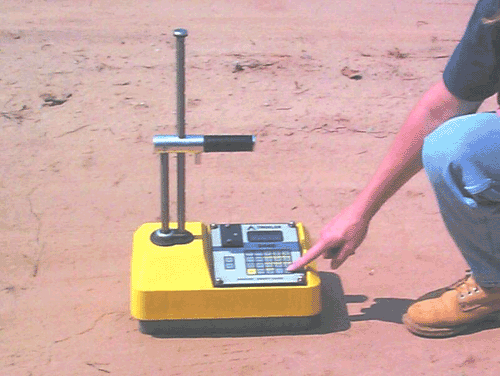
The old school of thought used compaction testing to calibrate construction methods. After the methods were calibrated, observation became as important as testing for quality control. Samples were taken at select locations based on observations. Today there is more of an emphasis on statistical characterization of constructed materials. Sample locations have become more random. Quality assurance specifications often give the contractor the responsibility of sampling and testing for process control. Testing by the owner includes some verification of the contractor's test results, and testing for acceptance and payment. The amount of payment may be determined by the statistical evaluation of test values resulting in pay factors (and no test reports, no pay).
As part of a good QC Plan, process control and measurement of the control can be a valuable tool. A test result, or trend of a measured value, may not directly demonstrate compliance or non-compliance, but tracking the measured value over time may help explain why another process is out of compliance. In the following example, a soil with a standard proctor maximum dry density of 15.7 kN/m3 (100 pcf) at an optimum moisture content of 20% is being placed in a single lift along a 300-m (1,000-foot) length of roadway embankment. The specification requires that a minimum of 95% of the maximum density be obtained, at or near the optimum moisture content. In order to simplify this example, it is assumed that the material is uniform in classification, and is being hauled by scrapers from a cut zone nearby. QC tests have been recorded and are graphically shown in Figure 8-2. This figure illustrates that the density is adequate along the first 120 m (400 feet) of placement, then trends toward an 'out-of-tolerance' or 'out-of-control' situation. The QC Plan may prompt the contractor to exert more compactive effort on this 'out-of-control' area, or change compactors; however, the moisture data suggests that the moisture content may be the 'out-of-control' parameter, which is, in turn, causing the density to move 'out-of-control'. By recognizing what part of the process is defective, the contractor begins spreading the cut soil in thin lifts, allows some drying to occur prior to compacting, and again returns to a product considered satisfactory at the 250-m (820-foot) mark.
Figure 8-2. Process control, field density and moisture. (3.3 ft = 1 m)
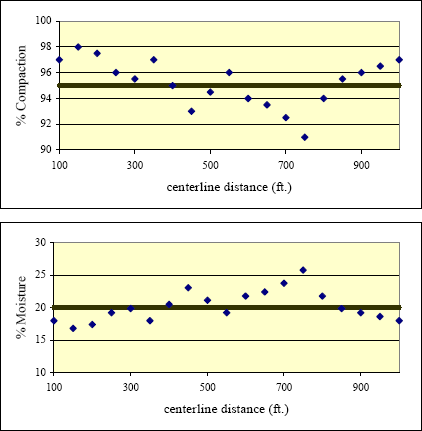
This form of process control (density or degree of compaction) is applicable to embankment, subgrade, and unbound aggregate base construction. In addition, gradation of aggregate base materials is an important process control measurement. Depending on location of sampling (on grade, from haul trucks, from stockpiles) segregation and contamination may be detected using this measure. It is also an important measure used to ensure that the quarry process (crushing and grading) is in control.
Chemical Stabilization
In addition to density and moisture measurements, several additional controls are required and considered good practice when stabilization techniques are employed. An excellent source for QC/QA requirements can be found in the Soil Stabilization for Pavements manual (Army, Air Force, 1994). Briefly, these elements include:
- Pulverization and scarification - An assessment of the material to be treated is required, and generally includes random sampling and testing using a field sieve (25-mm (1-in.) and 4.75-mm (No. 4) sieves).
- Stabilizing agent content - The amount of modifier added to the soil should be measured, and generally includes sampling the discharge using a canvas of known area placed on the soil to be treated, or calculating the area over which a known tonnage has been spread. For lime stabilization, pH can provide a good indication that the correct dosage has been achieved, as discussed in Appendix E.
- Uniformity of mixing - Visual observation is made to ensure that uniform mixing has been accomplished throughout the full depth of treatment. The use of phenolphthalein indicator solution has been used effectively for lime treatments to indicate depth of treatment. This solution - a light spray applied to the sides of a hand-excavated hole in the treated soil - will react with the lime, turning a brilliant pink color.
- Compaction and moisture control - Covered in the previous section.
- Curing - Curing is essential to assure that the modified soil mixture will achieve the final properties desired. The use of moist curing (light sprinkling of water) or membrane curing (application of a bituminous coating) is common. Regardless of method, the entire area must be properly sealed, and documentation of this activity is required.
Again, most QC programs only measure the compaction of the earthwork operation. While this methodology is valuable, density does not necessarily translate into performance. This type of QC testing is still very important in that it provides for a uniformity in the contractor's work, and can control the moisture of a given soil type at or near its optimum moisture content. This moisture control is important in order to minimize volume change characteristics, and none of the technologies described above have this capability.
8.3.2 QC/QA: Emerging Technologies
Lost in most projects requiring earthwork operations is the design intent. While the industry has accrued decades of experience founded upon successful engineered and constructed projects, we still observe the occasional premature failure that could have possibly been avoided. Reviewing, site soils are improved for three reasons:
- there are large quantities available;
- the natural state is inadequate to support the intended structure; and
- it is cost-effective.
For embankment fills, shear strength (slope stability) and consolidation (settlement potential) are used in the engineering analyses for design intent. As the elevation gets closer to the final grade (below the granular layers and surface layers - or within the anticipated depth or zone of repeated loading influence) resistance to deformation - stiffness or resilient modulus - is used in the engineering analyses for design intent. These parameters are measured in the laboratory on soils sampled in the soil exploratory phase of the design. In essence, the design parameters are rationalized as an anticipated, educated estimate of what will finally be obtained in the field. But rather than measure these design parameters in the field, we commonly accept the contractor's work based on a result specification measurement of density. While this may be common and traditional, it does not verify if the design intent has been met.
As an example, the following scenario represents a hypothetical design situation where a 0.4-km (¼-mile) roadway, 2 lanes wide is to be constructed along a gently rolling topography. Based on soil borings drilled and samples obtained, classified and tested, Table 8-3 was compiled for five uniquely different soils (based on visual description and engineering classification) ranging from a sandy soil to a highly plastic clay. The five samples are identified as Samples A-E.
| Physical Property | A | B | C | D | E |
|---|---|---|---|---|---|
| Liquid Limit, LL | 21 | NL | 35 | 64 | 36 |
| Plastic Limit, PL | 16 | NP | 14 | 29 | 27 |
| Plasticity Index, PI | 5 | - | 21 | 35 | 9 |
| P4 (%) | 94 | 100 | 100 | 100 | 100 |
| P10 (%) | 92 | 100 | 100 | 96 | 96 |
| P200 (%) | 47 | 20 | 59 | 82 | 48 |
| Maximum Dry Density1, γmax | |||||
| (kN/m3) | 18.8 | 18.2 | 16.9 | 14.9 | 17.8 |
| (pcf) | (119.8) | (115.9) | (107.8) | (94.7) | (113.3) |
| Optimum Moisture Content, wopt (%)1 | 12.0 | 11.8 | 17.2 | 25.6 | 15.0 |
| AASHTO Classification | A-4 | A-2-4(0) | A-6(9) | A-7-6(32) | A-4 |
| Unified Soil Classification | SC | SM | CL | CH | SC |
| Resilient Modulus Parameters2 | |||||
| K1 | 10 387 | 6246 | 10 274 | 10 362 | 7938 |
| K2 | -0.015483 | -0.00836 | -0.41797 | -0.18345 | -0.21171 |
| K3 | 0.23229 | 0.30028 | 0.08425 | 0.12762 | 0.23770 |
In this hypothetical example, it is assumed that each of these materials will be equally represented along the length and width of the project, and are semi-infinite in depth. Further, the design assumes each material will be field compacted to 95% of the soil maximum dry density at or very near its optimum moisture content. Lastly, it is assumed that the soil mass will remain at this condition for the performance period. Each of these assumptions is idealistic, not realistic. However, it can be demonstrated that the design intent for this hypothetical example can be verified in the field during construction. In this example (Boudreau, 2003), the design intent is a roadbed stiffness of 20 Mpa (7200 psi) based on a stress state of 36 kPa (5.3 psi) vertical and 11 kPa (1.6 psi) horizontal (as estimated by the pooled subgrade constitutive model Mr = 9041 σv-0.19526 σh0.19643 with σv, σh in English units).
- Maximum dry density and optimum moisture content, as determined by AASHTO T-99 (standard Proctor).
- For modulus equation: Mr = K1SVK2S3K3 with SV and S3 in English units. Laboratory test specimens prepared to 95% of maximum dry density at optimum moisture content (as determined by AASHTO T99).
Based on the information provided, a conventional pavement cross section resulting from the subgrade support conditions, determined from the pre-construction laboratory test program summarized in the table above (analyses performed per AASHTO 1993 Design Guide using estimates for traffic and other inputs per the Boudreau reference cited) is 140 mm (5.5 in.) of asphalt concrete on 200 mm (8 in.) of a crushed aggregate base. The question is, if the contractor satisfies the result specification for subgrade construction - for this example, the contractor must achieve 95 percent compaction at or very near optimum moisture content - and the layers above (140 mm (5.5 in.) of asphalt concrete and 200 mm (8 in.) of a crushed aggregate base) are constructed with approved materials and constructed to satisfy the result specification for these layers, will the pavement perform as designed and expected? The answer deserves some examination.
First, the design intent for the subgrade is stiffness and strength; the measure of acceptance is density. Fundamentally, these two measures are uniquely different; one measure does not necessarily confirm the other measure. It is possible that the contractor has met the compaction specification on the wet side of optimum. The important measure is one of stiffness - in this hypothetical example, 50 MPa (7200 psi).
There are a number of ways to more precisely measure whether the design intent has been satisfied. These measures could include field CBR and plate load tests, dynamic cone penetration (DCP) tests, correlation studies, and/or laboratory tests performed on undisturbed tube samples obtained at finished grade. More recently, nondestructive testing (NDT) methods, including lasers, ground-penetrating radar, falling weight deflectometers (FWD), mini or portable lightweight FWD (LWD) cone penetrometers, GeoGauge (providing direct stiffness measurements), and infrared and seismic technologies, have been significantly improved and have shown potential for use in the quality control and acceptance of flexible pavement construction. As mentioned in Section 8-4, another technology in development consists of instrumented compaction equipment. This and the others mentioned above require field verification studies prior to any endorsement of the technology. The thrust of NCHRP Project 10-65 is to explore many of these technologies for this specific application (Von Quintus et al., 2004). It is anticipated that some of these techniques will eventually be incorporated into performance specifications as the industry gains more knowledge and accrues more experience with them. Many of these techniques were briefly reviewed in Chapter 4 (see Tables 4-2 through 4-6) and are described in greater detail below.
With the advent of the much anticipated NCHRP 1-37A Pavement Design Guide and extended warranty period of performance, there is an ever increasing need to measure layer stiffness properties by owner agencies, an activity that is not presently a typical component in the acceptance of a completed project.
Proof Rolling
A practical approach that many agencies use is the concept of proof rolling, as discussed in the Section 8.3.1. Although this approach is observer-dependant, many agencies use the technique not to measure design intent (deformations anticipated at stress levels typical under repeated load traffic protected by layers of material would result in deformations undetectable to the human eye during a proof rolling exercise), but to evaluate gross deficiencies including soft, yielding, or pumping subgrade. The objective of this type of process is to correct problem areas prior to the placement and compaction of stronger, more expensive materials (these soft zones will surely be detected during finishing operations of the stronger layer materials in the form of roller cracks).
With newer more sophisticated technology, including lasers, digital video, and image analysis, it is possible to take proof rolling to a new level of direct stiffness measurements. Small deformations can now be monitored as the proof roller moves across the site. Although this is somewhat of a research topic at this time, the concept is fairly straightforward to develop. In fact, Wisconsin DOT has developed a prototype deflection measurement system for use with a loaded dump truck, using ultrasonic sensors and a micro-controller, in order to continuously and objectively proof roll subgrade soils. Wisconsin DOT concluded that a threshold value of 38 mm (1.5 in.) of deflection indicated "failed" areas that required corrective action, and also found value in analyzing the ratio of the 0-offset and 0.6 m-offset (24 in.) sensors to determine depth of weakened zones (Wisconsin DOT, 2002).
Field CBR or Plate Load Tests
These technologies were developed several years ago and were employed as a measure for verifying design intent. Each included mobilization of equipment (moderate to heavy plates, loading rams, calibrated proving rings or load cells, and dial indicators or electronic deflection measurement devices) crew and heavy reaction vehicle (typically readily available on an earthwork construction project in the form of a scraper or track-mounted excavator/shovel). These tests are often the standard for quality programs in Europe, but have not typically been utilized in the U.S., based on their relative cost, time involved to set up and perform the test at a specified location, and accuracy issues. The field CBR test could measure the in-situ CBR of finished subgrade in order to verify design intent for flexible pavements, and the plate load could directly measure the modulus of subgrade reaction, or k-value, for rigid pavements. The plate load test is the standard practice in Europe for all pavement types.
Each of these measures is time-consuming; thus, only a few locations could be tested per day, oftentimes impeding the earthwork contractor's progress. In cut zones, these tests measure soil properties that are not controlled by the contractor, thus it is often difficult to expect the contractor to achieve a predetermined CBR or k-value threshold without paying for corrective measures.
It is noted that this type of testing is common and traditional in many European countries, using special customized equipment to make this type of testing more automated and more productive than that described above.
Dynamic Cone Penetration (DCP) Tests
The DCP technology consists of a steel shaft with an instrumented penetration head conforming to a precise configuration, as was described in Table 4-9. The instrumentation is capable of measuring resistance per increment of advancement and used with correlations to estimate stiffness of the materials. The benefits of this form of measurement are that the device can be quickly and efficiently mobilized to the project site (can be hand-carried or mounted inside a vehicle) and can measure to depths beyond surficial soils. The drawbacks include discrete point evaluations - leaving zones between points unknown, and the fact that the information gathered is used to correlate stiffness and strength. Thus, is only as accurate as the correlation models used. However, an added value is that the DCP can readily indicate soil support via correlations for construction activities. For example, if the estimated in-situ CBR has a value of 6 or less, the soils are expected to rut and deflect under construction operations. If the estimated CBR values are between 6 and 8, the soils are considered marginally suitable for construction support (Illinois DOT, 1982).
Resilient Modulus Testing
The design for the example introduced at the beginning of this section was based upon several soil samples characterized in the laboratory. The soils selected for characterization were those anticipated in the uppermost zones of the finished subgrade. In order to verify design intent, it would seem logical that samples of the earthwork contractor's finished work be sampled and characterized in a similar fashion. This can be accomplished by extending short Shelby tubes into the compacted soil and returning to the laboratory for resilient modulus testing. The testing can occur on extruded tube samples the same day they are obtained from the field. Thus, final reporting can be available the next day. This form of sampling and testing has the benefit of comparing actual results with those used for design purposes. Additionally, these measures are direct; therefore they are not reliant upon correlations. Lastly, because these samples are physical in nature, the density and moisture content will be measured and can be compared with the QC test results for accuracy of the QC testing program.
Falling Weight Deflectometer (FWD) Tests
A very mobile device and one that can be utilized to examine the stress dependency of the embankment or roadbed soils, a falling weight deflectometer is basically a trailer-mounted piece of equipment, which drops a weight transmitted through a hard rubber-type pad to the surface (as covered in detail in Table 4-2). The van pulling the trailer is equipped with a computer data acquisition system that measures the load and offset surface deflections. For field control, there are also portable or lightweight LWD units (as shown in Figure 8-3), allowing an individual to carry the unit around in any vehicle.
Figure 8-3. Lightweight deflectometer (photo courtesy of Dynatest).
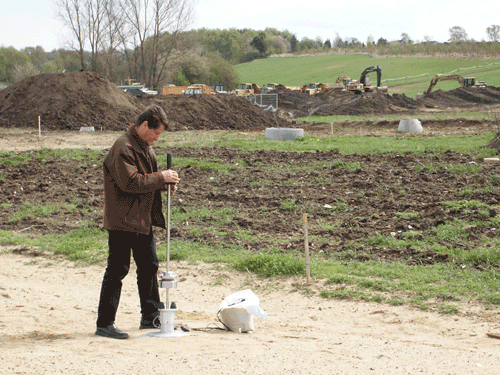
This technology, with sophisticated computer models, can directly measure the roadbed deflection from which modulus values can be estimated in order to verify design intent. The device is relatively quick (less than 4 minutes is required per location to measure the properties), thus numerous locations can be measured per hour. There are also several new developments with units mounted on sleds or skis such that continuous coverage along the length of a project is possible.
GeoGauge
A recent development is the GeoGauge, a lightweight unit capable of measuring stiffness at discrete points. The Federal Highway Administration is currently evaluating this technology in the form of a Pooled-Fund Study. This device has many perceived benefits, including the capability to measure the stiffness of a composite soil mass directly and quickly such that numerous discrete points can be evaluated per hour.
Seismic Methods
The Portable Seismic Pavement Analyzer (PSPA) and a derivative modified for base and subgrade measurement, the Dirt Seismic Pavement Analyzer (DSPA), are currently being used on a trial basis by the Texas Department of Transportation for QC/QA purposes (Nazarian, 2002). The operating principal of the PSPA is based on generating and detecting stress waves in a medium. If used appropriately, analyses of the stress waves can be used to determine the modulus of the layered material, as well as assess the thickness of the layer (aggregate base). These techniques are being utilized with very promising results during construction on a few projects in Texas, and are being considered for quality control on pavement warranty projects in Texas and New Mexico. This method of measurement and analysis are very similar to the principals used in spectral analysis of surface waves (SASW, Table 4-6).
Automatic Controlled Variable Roller Compaction and Documentation System (Intelligent Compaction)
While each of the aforementioned techniques have perceived advantages and disadvantages, none of the techniques described above has the capability to continuously evaluate design intent along the entire length of a project. The use of instrumented compaction equipment would appear to have some potential for continuously monitoring conditions along a length of a project.
The real-time automatic controlled variable roller compaction and documentation system (a.k.a. intelligent compaction) allows for optimization of compaction rates and real-time quality control. The system works by using accelerometers to monitor the speed of the dynamic wave through the soil, induced by the vibratory rollers, in order to measure the dynamic stiffness of the soil, which generally increases with higher compaction. Efficient fill densification is achieved via automatic adjustment of compaction energy and the measurement/documentation feedback, eliminating time wasted on compacting areas that are already adequately compacted. This energy variability and efficiency is achieved by the use of two counter rotating weights in the drum, rather than the conventional single, one-directional eccentric weight. The weights rotate in opposite directions and only come together in a common direction in the downward vertical inclination. This eliminates unwanted and wasteful movements in the lateral and upward directions that occur with conventional compaction drums. Internally, the entire counterweight assembly is rotated to adjust the direction of the point where the two weights act together. If the onboard monitoring system determines the soil is compacted to a satisfactory level, it will automatically reduce the vertical component of force at the specific time and location.
In addition, the ability to monitor density improvement during compaction both speeds up and improves the aerial extent of quality control. Most importantly, the ability of instrumented compaction equipment to provide 100% quality control coverage enables the use of performance based approaches to specifications, and the effective implementation of warranties and guarantees for both earthwork and pavements.
This method does require proprietary specialized monitoring equipment, but the equipment and process are not patented. The equipment is readily available in the U.S., and requires nominal operator training.
8.3.3 Risk Acceptance
Warranties for materials and workmanship are common in the construction industry, with most performance bonds covering such items for 1 year following completion of a project. However, the new emphasis on warranties for highway construction involves the guarantee of the long-term performance of highways. Typically, a long-term warranty is considered to cover a period from 2 - 5 years. It is beyond the generally accepted standard warranty period of 1 year. This creates a very difficult situation, and one that involves a very high degree of uncertainty with our current state of practice and technology in the United States highway construction industry (Hancher, 1994 - NCHRP Synthesis 195).
This shift in philosophy has basically brought about a shift in project risk. Traditionally, the owner has assumed nearly all the performance risk by developing the design, specifying materials, and either specifying the results (density) or method to achieve the desired result, and measuring and accepting the contractor's work. The contractor is at risk for gross failures resulting from noncompliance with contract requirements detected in the first year of performance, while the owner assumes responsibility for failures and maintenance following the initial year of performance. By extending the initial warranty period from 1 year to a period up to 5 years, the owner has shifted some of this inherent risk to the contractor. As a result, the contractor has been tasked with becoming a more integral part of the design and construction process.
Extending the period of performance and assigning performance risk to various parties has lead to more sophisticated approaches with respect to life-cycle performance monitoring, early detection of potential problems, cost analyses, and budget optimization. For a contractor to be willing to accept more risk, he or she should have a more active role in design.
8.4 Construction And Construction Monitoring
Construction of the pavement involves grading to provide a uniform support layer(s) at the appropriate elevation. In modern construction, either major earthwork or reconstruction, sophisticated equipment is available to excavate, haul, add water, aerate (decrease water), spread, and compact to achieve this purpose. The objective of this type of operation is to achieve a structure with specific design intent. Most earthwork projects have the additional objective that transforms existing or natural topography to an acceptable and safe vertical and horizontal alignment. A common goal is to achieve this new alignment with a balance of site materials. Projects that require more soil in fill areas than can be produced from cut zones will require additional materials from off-site borrow sources. Projects that generate more material from cut zones than can be placed in fill areas will be wasted.
The construction process is described in this section, along with the requirements for monitoring each phase of the construction activities, as outlined in Section 8.3 and summarized in Table 8-2.
For new construction, subgrade preparation will typically require grubbing and grading (either cut or fill) to meet subgrade elevation requirements. In either case, clearing and grubbing is very important to remove vegetation, debris, and any organic, soft, or otherwise unsuitable materials from the surface of the site, either at subgrade level or before placing fill. For reconstruction, the old roadway surface will be removed (possibly recycled), possibly along with the base and subbase layers, if they are not suitable for support (i.e., intermixed with large amounts of fine-grained soil). Observation of heavy equipment operations on the site at this phase provides the first indication of the subgrade adequacy. Rutting and deflection during initial earthwork operations indicates an immediate problem. This may not be a problem if significant undercut or stabilization was anticipated prior to construction. However, if soft materials are encountered at subgrade or initial fill elevation and were not anticipated, immediate action should be taken. In either case, the conditions must be improved.
In order to improve the soil conditions at a site, a couple of options are common:
- Remove marginal soils and replace with select material of higher quality.
- Stabilize in-place soil (using one of the many techniques discussed in Chapter 7).
- Improve site drainage.
Often the removal and replacement alternative is used because it appears to be the easiest. This is generally true for small areas or areas where spot locations are identified. However, undercutting may not be the most effective or even desirable for large areas. Excess water in soil is the principal cause of unstable conditions, and reducing the soil water content either by dewatering or stabilization methods may offer a better solution to expedite construction. Hauling or loading on a wet subgrade may continually disturb the section. Excavation in wet conditions often leads to more excavations. The variation of soil types and saturation levels should be evaluated by subsurface investigation to determine the vertical and longitudinal extent of the problem before a decision is made on which method to use. Excavation, drainage, and confirmation of stabilization will be reviewed in greater detail in the next section on construction techniques.
Proper consideration of existing conditions should be given prior to earthwork construction. For example, areas that are to receive fill soils should be cleared and grubbed (i.e., vegetation, organic soils, and weak or otherwise unsuitable soils removed). Long-term performance issues are often traced to inadequate removal of unsuitable materials. Removal of surface soils containing organic matter is important, not only for settlement, but these soils are often moisture sensitive, losing significant strength when wet, and are easily disturbed under construction activities. Site QC/QA personnel should monitor and confirm that these organic soils have been adequately removed. Documentation should including a visual description along with photos of the cleared surface. If additional excavation will not be made, the surface should be checked at this point for compliance with specification requirements. This will often require proof rolling or other testing such as DCP. Unsuitable materials also often find their way back into filling operations. Therefore, the control of unsuitable materials should also be documented. Other special earthworks should also be observed and documented, including embankments properly sloped to prevent slides, keyways (a.k.a. shear keys) constructed to avoid toe slope failures, and erosion protection techniques to maintain long-term stability. Large embankments can cause settlement of the natural soils, thus analyses examining settlement potential of underlying soils is essential. If settlement is anticipated, techniques such as removal-and-replacement or surcharge embankments can be utilized to mitigate the problem (See FHWA NHI-00-045, 2000).
In unusual circumstances, a roadway alignment may be constructed over large voids or weakened soil zones, such as caves, faults or collapsed, abandoned mines, and sinkholes. Detection of these underlying potential problems prior to construction is ideal. Geophysical techniques such as ground penetrating radar (GPR) or spectral analyses of surface waves (SASW), again as described in Chapter 4, may be used in conjunction with historical information and experience to detect or predict the likelihood of encountering these described problems. Mitigation may include excavation and backfill operations, injection grouting, or grout columns using tubular fabric forms. For very localized areas and in karstic regions where voids are random but anticipated to be small, there has also been some success with bridging such areas with thickened reinforced concrete slabs or reinforced base and subbase using geogrids or welded wire mesh. However, for these techniques to be successful, the areal extent of the subsidence area must be clearly defined.
8.4.1 Drainage
If conditions exist during construction that indicate the need for underdrains (e.g., wet, saturated conditions) or the cleaning of the existing underdrains outlets, then this work should start as soon as possible (after Ohio DOT, 2002). Some examples of these conditions are as follows:
- existing underdrains with clogged outlets on rehabilitation projects
- free water in the subgrade
- saturated soils of moderately high permeability, such as sandy silt and silty clay of low plasticity
- groundwater seepage through layers of permeable soil
- water seeping in the test pits
- water seeping from higher elevations in cut locations
- water flowing on the top of the rock undercuts
Significant subgrade stability improvement can be obtained by cleaning out the existing underdrain outlets on rehabilitation projects and by adding construction underdrains on new construction projects. The FHWA/NHI course manual on Pavement Subsurface Drainage Design is a useful reference. Once the underdrain systems are in place and functioning, the drainage system can typically reduce subgrade pumping problems within a few days, but may take longer depending on the characteristics of the in-situ materials. Soils that are subject to densification and are not free draining (percent saturation exceeding 80 - 90%) within 1 m (2 - 4 ft) of the surface are not expected to support construction traffic. This order of magnitude of saturation is frequently observed to be the limit for compaction stability when developing moisture-density curves in the laboratory. Saturated soils with more than 10% fines (minus 0.075 mm (No. 200) sieve) are not expected to be drainable with respect to supporting construction traffic. Moisture reduction by evaporation (e.g., disking and aeration) may be more feasible than gravity drainage for these types of soils.
For rehabilitation projects, the Contractor should be instructed to unclog the underdrain outlets immediately, attempting to perform this work in the timeframe listed above. If the project consists of several phases, then the Contractor should perform the outlet cleaning for the entire project at the same time. Because of the timeframes involved, construction underdrains should not be used for rehabilitation projects.
For new construction projects, subgrade stability can be achieved by constructing the plan or construction underdrains as soon as the water problem is found (see Figure 8-4). New construction projects can allow a longer period of time for the underdrain system to work. At the beginning of construction, and certainly before winter shut down, are opportune times for this work.
Figure 8-4. Underdrain installation (photo courtesy of Ohio DOT).
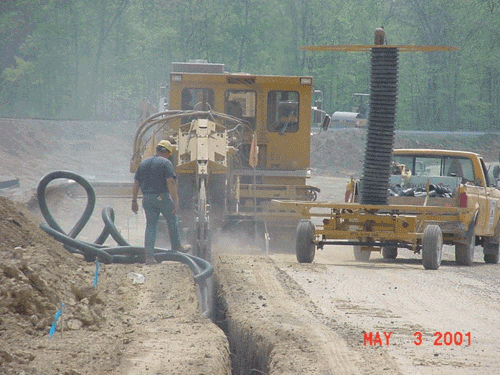
The plan underdrains should be placed only when they will not be contaminated by further construction. If contamination is a concern, then sacrificial or temporary construction underdrains should be used on the project.
Construction underdrains are usually placed in the centerline of the roadway. They may also be placed in the ditch line, if the water is coming in from a cut section at a higher elevation. The porous backfill is extended to the subgrade elevation. The outlets for the construction underdrain are the same pipe material and backfill as regular underdrains. The underdrains can be outlet to any convenient location. Some potential outlet locations are catch basins, manholes, pipes, or ditches. The project should not be concerned with the contamination in the upper portion of construction underdrain backfill. Construction underdrains are sacrificial underdrains that will continue to work throughout the life of the contract and afterwards even though the upper portion is contaminated.
For rock or shale cuts, the design underdrains should extend at least 150 mm (6 in.) into the existing rock formation. If the underdrains are too high, the water will accumulate at the rock and soil interface and cause subgrade instability.
8.4.2 Excavation
Most construction projects will consist of some amount of excavation, or removal of in-situ soil to some design elevation or grade line. Excavation is typically accomplished using scrapers (also referred to as pans) or shovels, which are among the list of heaviest equipment used in modern earthwork. Observations made at this stage of construction are considered the first line of QC documentation. Site personnel should observe vertical movements below the construction equipment during excavation. Moderate to large deflections are the first indication that weak soils exist and some corrective action may be necessary.
Scrapers have the ability to remove material from grade and spread at another location nearby. Some scrapers may need to be pushed by another scraper or by a bulldozer in order to advance while cutting into the zone of soil to be removed. Other scrapers are equipped with an elevator system (Figure 8-5) that allows the excavated material to be readily loaded without the assistance of a push from behind.
Figure 8-5. Self-loading scraper (photo courtesy of Caterpillar).
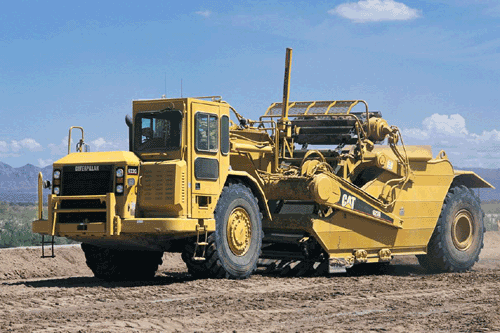
Scrapers are commonly used in cut-fill earthwork operations, where the majority of the soil excavated is placed along another portion of the project. Anticipated site conditions that consist of wet or saturated soils due to water table elevations may necessitate the use of other forms of excavation equipment in order to minimize disturbance to the underlying in-situ soils. A common piece of equipment is the track-mounted excavator (shovel) like the one illustrated in Figure 8-6. Materials removed or excavated by this means require transfer to a secondary piece of equipment for hauling off site, or to another location along the alignment where fill soils are required.
Figure 8-6. Track-mounted excavator (photo courtesy of Komatsu).
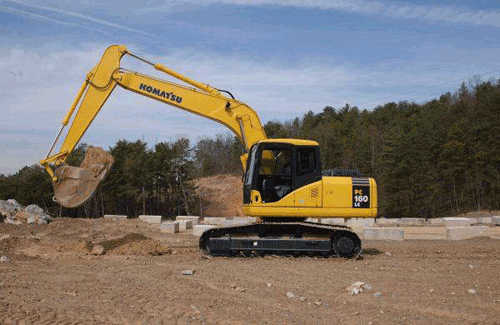
8.4.3 Hauling and Placement
While scrapers (a.k.a. pans) transport their payload from a cut zone to a fill area, shovels require a haul truck to be utilized. There are several types of hauling vehicles, including end dump, side dump, bottom dump (or belly dump), and articulated dump trucks, as illustrated in Figure 8-7.
Figure 8-7. Articulated dump truck (photo courtesy of Komatsu).
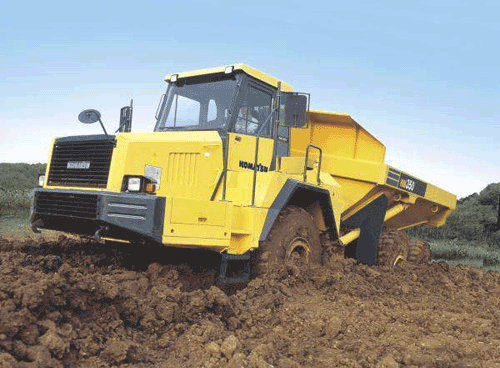
Some projects will require off-site materials to be hauled in because of an imbalance of site materials. These borrow materials will typically be hauled in trucks and dumped near their intended final location. Depending on the dumping method, these piles may require spreading using a bulldozer or motor-grader (shown in Figures 8-8 and 8-9, respectively). Again, observation of this activity can indicate soft or unsuitable areas that will require special treatment. When excessive rutting is noted, haul routes should be changed so as to minimize the depth of disturbance. An assessment by the engineer should be made as soon as practical to determine if underdrains are needed. Often, well-placed and well-timed construction underdrains can mitigate the problem, and hauling over the previously unstable location may improve the stability by adding compaction to the draining soils.
Figure 8-8. Bulldozer (photo courtesy of Komatsu).
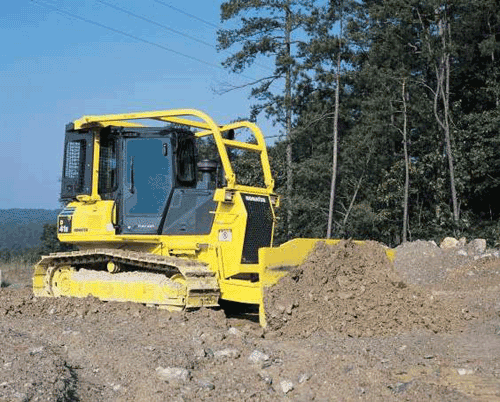
Figure 8-9. Motor grader (photo courtesy of Caterpillar)
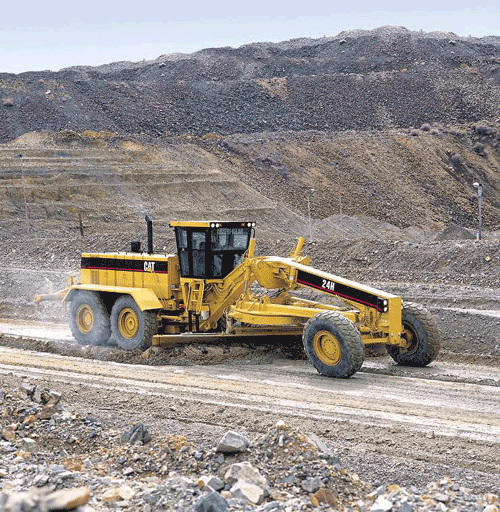
Some projects may restrict hauling on existing paved roads in order to eliminate damage to existing local roadways. In this case, it is possible to utilize a conveyor system to transport the borrow material to the site, like the one shown in Figure 8-10.
Figure 8-10. Earth-moving conveyor system (Atlanta Airport - 5th Runway Embankment Placement).
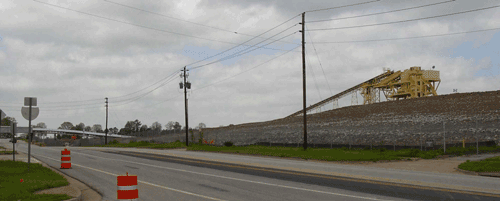
During the hauling operation, material to be used as fill should be sampled and tested by QC/QA personnel for compliance with the specification requirements (e.g., soil type, gradation, etc.) Laboratory moisture-density tests (a.k.a. Proctors) should also be preformed for correlation with field density testing.
8.4.4 Field Compaction
Compaction can be defined as the densification of soils by the application of mechanical energy, oftentimes requiring a modification of water content. The purpose of compaction is generally to enhance the strength or load carrying capacity of the material, while minimizing long-term settlement potential. By adjusting the moisture content to a value at or near a moisture content considered optimum - as described below - reduced volume changes and increased strength can be achieved.
Significant advances have been made in the science and technology of earth structures in the last century. In the early 1900s, soils were placed in embankments by end dumping from wagons, with little attempt to compact. Structures that were placed by hand using baskets had, at a minimum, foot traffic to unintentionally "compact" the soil. It was observed that this foot traffic actually strengthened the soil, thus creating the concept of mechanical stabilization. Different types of field compaction equipment are appropriate for different types of soils. Steel-wheel rollers, the earliest type of compaction equipment, are suitable for cohesionless soils. Vibratory steel rollers have largely replaced static steel-wheel rollers because of their higher efficiency. Sheepsfoot rollers, which impart more of a kneading compaction effort than smooth steel wheels, are most appropriate for plastic cohesive soils. Vibratory versions of sheepsfoot rollers are also available. Pneumatic rubber-tired work well for both cohesionless and cohesive soils. A variety of small equipment for hand compaction in confined areas is also available.
Recommended field compaction equipment for various soil types is summarized in Table 8-4. The effective depth of compaction of all field equipment is usually limited, so compaction of thick fills must be done in a series of lifts, with each lift thickness typically in the range of 150 - 300 mm (6 - 12 in.) with greater depths possible (up to 0.7 m (2 ft)) through the use of specialized high energy equipment and the right type of soil conditions (e.g., free-draining granular soils). The soil type, degree of compaction required, field compaction energy (type and size of compaction equipment and number of passes), and the contractor's skill in handling the material are key factors determining the maximum lift thickness that can be compacted effectively. Control of water content in each lift, either through drying or addition of water plus mixing, may be required to achieve required compacted densities and/or to meet specifications for compaction water content.
| Soil | First choice | Second choice | Comment |
|---|---|---|---|
| Rock fill | Vibratory | Pneumatic | - |
| Plastic soils, CH, MH (A-7, A-5) | Sheepsfoot or pad foot | Pneumatic | Thin lifts usually needed |
| Low-plasticity soils, CL, ML (A-6, A-4) | Sheepsfoot or pad foot | Pneumatic, vibratory | Moisture control often critical for silty soils |
| Plastic sands and gravels, GC, SC (A-2-6, A-2-7) | Vibratory, pneumatic | Pad foot | - |
| Silty sands and gravels, SM, GM (A-3, A-2-4, A-2-5) | Vibratory | Pneumatic, pad foot | Moisture control often critical |
| Clean sands, SW, SP (A-1-b) | Vibratory | Impact, pneumatic | - |
| Clean gravels, GW, GP (A-1-a) | Vibratory | Pneumatic, impact, grid | Grid useful for over-sized particles |
Proof rolling with heavy rubber-tired rollers is often used to achieve additional compaction beyond that from normal compaction and, more important, to identify any remaining soft areas. The proof roller must be sized to avoid causing bearing capacity failures in the materials that are being proof rolling. Proof rolling is not a replacement for good compaction procedures and inspection. QC/QA personnel need to be present on site to watch the deflections under the roller in order to identify soft areas. Construction equipment, such as loaded scrapers and material delivery trucks, can also be used to help detect soft spots along the highway alignment. Details on the determination of suitability using proof rolling methods were provided in Section 8.3.
It is very difficult to achieve satisfactory compaction if the lift is not on a firm foundation. Figure 8-11 shows a typical stress distribution under a rubber-tired pneumatic roller for two different foundations. The first case corresponds to a homogeneous deposit with a constant modulus of elasticity equal to 170 MPa (25,000 psi), which is representative of a good quality granular material. The second case corresponds to a 150 mm (6-in.) thick lift of 170 MPa (25,000 psi) granular material over a subgrade soil having a modulus of 35 MPa (5,000 psi), which is representative of a soft clay having a CBR of around 3 or 4. As is clear from the figure, the stresses induced by the roller in the second case are much lower than in the first. High levels of compaction will be difficult to achieve in the thin lift over the weak subgrade, and the high stresses in the lower soil may produce shear failure and excessive rutting, especially if proof rolling is performed. Thus, it is easy to see the importance of monitoring cut surfaces through proof rolling and measuring compaction of each lift during fill placement.
Figure 8-11. Stress distributions under rollers over different foundations (after Rollings and Rollings, 1996). (1 ton = 8.9 kPa, 1 psi = 6.9 kPa)
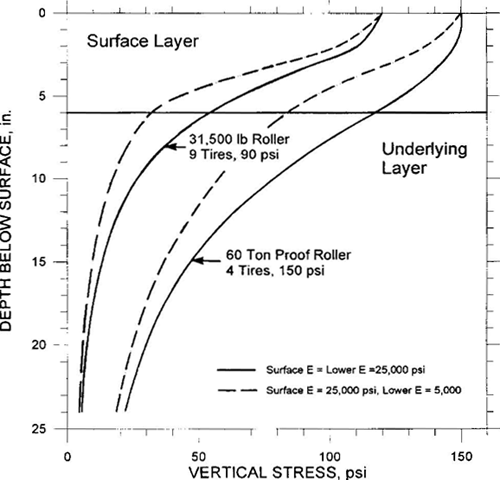
The most common measure of compaction is density. Field moisture and densities can be measured using a variety of standard methods. Field density is correlated to moisture-density relationships measured in the lab (AASHTO Test Procedures T99 and T180). Moisture-density relationships for various soils are discussed in Chapter 7, and the lab tests are covered in Chapter 5. Optimal engineering properties for a given soil type occur near its compaction optimum moisture content (wopt or OMC), as determined by the laboratory test standard. At this state, a soil's void ratio and potential to shrink (if dried) or swell (if inundated with water) is minimized.
In controlling compaction, the appropriate moisture-density laboratory method (e.g., standard or modified Proctor) should be matched to the equipment typically used in the local region. Higher energy equipment should be controlled with compaction tests based on high energy (i.e., modified in lieu of standard Proctor). There is a trend to lower moisture content tolerances with consideration for the higher energy equipment; however, this method could result in lower compactive efforts. The reason for this move is that the high-energy compaction equipment is causing an apparent pumping to occur when the soil is above its optimum moisture. However, this method could ultimately lead to premature failures as the subgrade saturates over time (e.g., loss in stiffness/strength, or potential volume change). It is considered good practice to compact at the optimum moisture content for the material used. If some deviation occurs, it is better to be on the wet side, rather than dry.
Compaction, or mechanical stabilization (i.e., water content adjustments and densification) is the most common and least expensive of all soil improvement techniques. Perhaps the most common problem arising from deficient construction is related to mechanical stabilization. The intent of mechanical stabilization is to maximize the soil strength (and minimize the potential volume change) by the proper adjustment of moisture and the densification at or near the ideal moisture content, as discussed in Section 8.4.4. Without proper quality control and quality assurance (QC/QA) measures, some deficient work may go unnoticed. This is most common in utility trenches and even bridge abutments, where it is difficult to compact because of vertical constraints. This type of problem can be avoided or at least minimized with a thorough plan and execution of the plan as it relates to QC/QA during construction, as reviewed in detail in Section 8.3. This plan should pay particular attention to proper moisture content, proper lift thickness for compaction, and sufficient configuration of the compaction equipment utilized (weight and width are the most critical). Failure to adequately construct and backfill trench lines will most likely result in localized settlement and cracking at the pavement surface.
There are several compaction devices available in modern earthwork, and selection of the proper equipment is dependent on the material intended to be densified. Generally, compaction can be accomplished using pressure, vibration, and/or kneading action. Heavy equipment, as measured by ground pressure, is utilized to accomplish the compaction process. Some heavy equipment have low ground pressures, such as tracked vehicles like bulldozers, and rubber-tire equipment like front end loaders and motor graders. The low ground pressures imparted by these types of vehicles are not effective at compacting soils; however, tracked vehicles do provide some limited compaction of granular, cohesionless materials by means of vibration.
A smooth drum roller is perhaps the most common of all compaction devices, capable of applying pressure across the width of its drum. Smooth drum rollers can consist of a single drum (Figure 8-12) or dual drum. Most drum rollers are equipped with oscillary vibrators to increase the energy transmitted to the surface of the layer being compacted. These smooth drum rollers are best suited for granular, relatively non-cohesive soils. Some agencies have used smooth drum rollers to finish subgrades prior to base construction, and have even employed them as a proof rolling instrument.
Figure 8-12. Smooth drum roller (photo courtesy of Bomag).
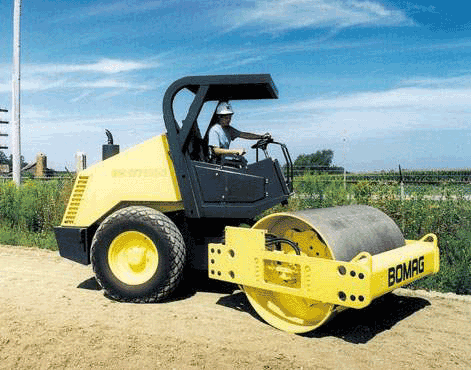
The sheepsfoot or studded rollers like the one shown in Figure 8-13 are typically used on cohesive soils. These rollers are very similar to the smooth drum roller, however, many rounded or rectangular protrusions (or feet) are attached to the drum. These protrusions provide for a very high contact pressure in a small zone of soil. By spacing these protrusions apart, very high vertical stresses, as well as horizontal stresses, are achieved, thus creating a kneading action that compacts from the bottom up. During compaction, the roller literally "walks out" of the lift once compaction is achieved. This kneading or shearing action has the ability to produce a soil structure that maximizes a cohesive soil's strength at high density levels. Some sheepsfoot or studded rollers are also equipped with oscillatory vibrators to increase the effectiveness across a broader range of soil.
Figure 8-13. Sheepsfoot roller (photo courtesy of Bomag).
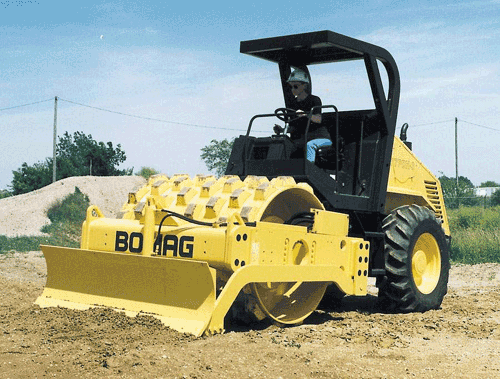
Pneumatic or rubber-tire rollers have also been utilized to compact materials. These compactors are typically used as an alternate for compacting a variety of soil types (see Table 8-4). They are particularly effective for non-cohesive silty soils. Some agencies have used them successfully in embankment placements and have also employed them as a proof rolling instrument. Hauling vehicles (scrapers and loaded dump trucks) have been used for compaction purposes.
The latest compaction equipment are high-energy impact rollers, which use shaped (e.g., triangular ellipsoids or hexagonal), as opposed to round drums, as shown in Figure 8-14. The high energy imparted by these systems allows them to achieve compaction at a faster rate and to greater depths. A comparison of different types of compaction equipment based on vertical settlement with number of passes is shown in Figure 8-15, demonstrating the superior effectiveness both in terms of number of passes and influence depth of high-energy equipment.
Figure 8-14. Impact roller.
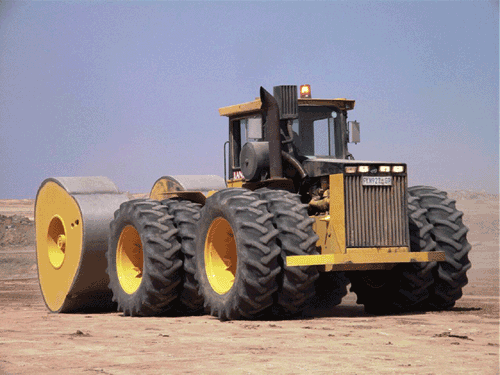
Figure 8-15. Compaction efficiency. (1 in. = 25 mm)
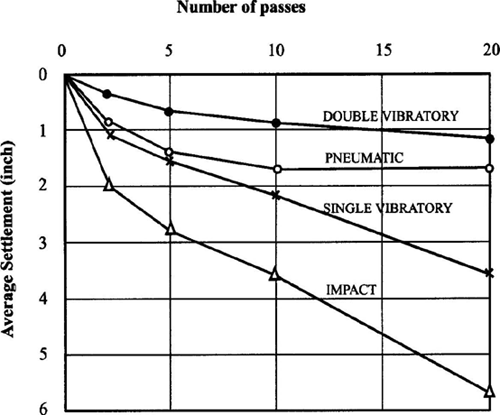
Most of the research on this equipment has been performed in Europe, and unfortunately the availability is limited at this time in the U.S. The Europeans are also experimenting with hydraulic and pneumatic impact hammers to achieve compaction at greater depths, especially in rubblized fills (Dumas, et al, 2003). This technique uses a 5-tonnes (5.5 ton), 1-m (3.3 ft) drop hydraulic pile hammer to drive a large foot into the ground. This technology eliminates excavation and allows for compaction of shallow layers (or soils with low moisture content) up to 3 m (9 ft) thick. The technique was initially developed by the British and U.S. military for rapid airfield repair.
Another significant development in compaction equipment is the use of instruments in the compaction drums to measure the response of soil (e.g., stiffness). The equipment is computerized, allowing for real-time monitoring of foundation response and automated feedback controlling vibration amplitude and frequency, and vehicle speed. While intelligent compaction equipment was originally developed for contractors to improve their efficiency in achieving compaction with a minimum number of passes, it has direct and significant application potential for controlling and monitoring compaction effectiveness for pavement performance, as discussed in Section 8.3 on QC/QA.
Other means exist in which to promote deep densification, including dynamic compaction and vibroflotation. These processes are discussed in the FHWA/NHI Ground Improvement Techniques reference manual (FHWA NHI-04-001) and, given the right conditions, can be used to densify soils at depths of over 9 meters (30 ft). Each is limited to successes achieved in deep, loose non-cohesive soils, such as sands and gravels.
As previously discussed, with the advent of newer higher energy compaction equipment, agencies should carefully evaluate their current specifications to meet these changing demands.
The final phase of subgrade construction is the confirmation of surficial support prior to placement of the base/subbase layers. One or more of the methods outlined in Section 8.3 should be utilized (e.g., proof rolling, DCP, FWD).
8.4.5 Stabilization
In certain instances, when stabilization is a more economical means of constructing a pavement section with the desired support characteristics, use of chemical admixtures, such as lime, flyash or cement, is common. These mixtures are typically designed in a controlled laboratory environment in order to establish volumetric properties, such as admixture design content, maximum density, moisture content, and strength, as discussed in Chapter 7.
Chemical Stabilization/Modification.
In the special case where lime (or other pozzolanic modifier such as cement or flyash) is to be utilized to enhance the load carrying capability of the soil, the additional effort of introducing the modifier to the soil and mixing prior to compaction is required.
The basic construction steps for chemical stabilization of subgrade soils are (1) pozzolan delivery and distribution; (2) mixing; (3) compacting; and (4) curing. Pozzolans can be applied to a soil either dry or as a slurry. In the case of dry lime, the lime may be either in the form of dry hydrated lime, which is very fine-grained and, thus, may pose dust control problems, or dry quicklime, which is granular and much less dusty.
The pozzolanic material specified for stabilization or modification is distributed along the road alignment, either via bags that are spread manually, by pneumatic trucks with spreader bars, or by dump trucks with controlled tailgate openings. Lime slurries can be mixed in a central mixing plant or in various types of portable mixing systems. A typical lime slurry mixture would consist of 0.9 tonne (1 ton) of lime mixed with 1900 liters (500 gal) of water to produce 550 tonnes (600 tons) of slurry with 31% lime solids (Transportation Research Board, 1987).
Adequate mixing of the pozzolanic material with the soil is critical; poor mixing is the leading cause of unsatisfactory stabilization results. Subgrade soils can be mixed on site with the pozzolan by disking, repeated blading, or by traveling rotary or pug-mill mixing equipment.
Figure 8-16. Roadway stabilizer/mixer (photo courtesy of Bomag).
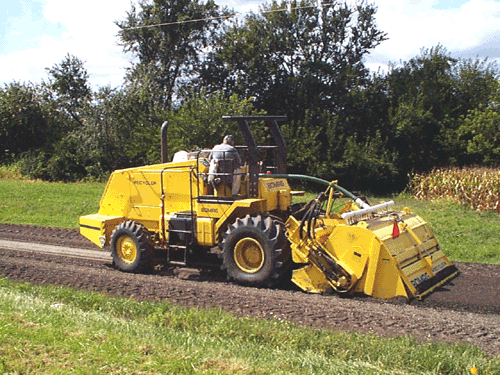
Mixing is usually done in thin lifts and often with multiple passes, with the lift thickness and number of passes dependent upon the soil type and the mixing equipment being used. A two-stage mixing process is sometimes used for highly plastic materials; the reduced plasticity and coarser texture that develops during curing for several days after the initial mixing makes the soil more workable for final mixing and compaction.
Compaction of chemically stabilized soil mixtures follows standard procedures. However, with respect to lime stabilization, the addition of lime will generally decrease the maximum density and increase the optimum water content at a given compaction energy, which may cause problems determining the percentage of specified density achieved by the field compaction. Compaction curves of the in-situ lime-soil mixture at the time of compaction may be required to determine the appropriate density values for field compaction control.
Curing at temperatures above 4.4°C (40°F) and with adequate moisture is essential for the pozzolanic reactions underlying the long-term strength gains in lime-stabilized soils. A cure period of 3 - 7 days is typically employed, with adequate moisture maintained either through moist curing (e.g., truck sprinklers) or by applying an asphalt seal over the surface.
Similarly, modified soil (lime, cement and/or flyash) will require special QC/QA considerations, as discussed in Section 8.3. Again, a final evaluation of the stabilized subgrade surface should be made by one or more of the methods described in Section 8.3 (i.e., proof rolling, DCP, FWD).
8.4.6 Base and Subbase Construction
In the case of aggregate base construction, material is hauled to the site and is typically placed directly on grade, spread to a uniform specified thickness, and compacted. Care must be exercised to minimize segregation of aggregate blends. Good practices to prevent or minimize segregation include eliminate the number of transfer points prior to final grade placement (avoidance of intermediate stockpiling), and minimize the amount of spreading and movement once on grade. Asphalt pavement spreaders have been successfully utilized to distribute aggregate base materials on grade. Use of such equipment allows good control of specified thickness and reduces the potential of segregation caused by traditional spreading techniques such as motor-grader or dozer operations. This practice can also positively affect the overall project profile smoothness objectives. Regardless of the method of placement, care should be exercised to avoid the potential to contaminate the aggregate with site soil. Contamination is typically introduced when wet soils adhere to construction traffic tires or tracks, and are "cleaned off" when traversing over newly placed aggregate layers. Again, QC/QA personnel should document observations and test results, indicating conformance or non-conformance with the specification.
Base and subbase layers are typically aggregate materials containing moderate (dense graded) to little (open graded or drainable) fines. Compaction is typically achieved utilizing vibratory smooth drum compactors described previously in Section 8.4.4. Failure to achieve proper compaction may be a result of several factors, either individually or in combination:
- Lack of substrate support (Should have been detected and corrected prior to placement of layer.)
- Improper size of compactor
- Excessive moisture (Perhaps from rainfall. Site surface runoff should be promoted. Excess moisture usually can be dried by blading and allowing excessive moisture time to evaporate.)
- Segregation
Correction in the form of drying and recompacting should work in the majority of cases. If problems persist, removal and replacement may be warranted. If the problem is deeper than the base or subbase layer, subexcavation and replacement or some form of chemical stabilization technique may be required, as discussed in Section 8.4.5.
Chemical Stabilization.
Mixing of lime or cement with coarse aggregates for base and subbase layers is often done in a central mixing plant. Although the central mixing plant is required primarily for gradation control, it also enables good control of the lime-aggregate or cement-aggregate proportions and mixing. Again, testing during construction should closely parallel that described for soil stabilization/modification.
8.4.7 Pavement Drainage Systems
For construction of pavement drainage systems, design should acquaint agency construction personnel with the impact of construction on the design results. Care during construction to build the pavement drainage designed section without compromising the effectiveness of design is essential to the pavement's long-term performance. Key performance elements for construction personnel to remember include:
- Good pavement starts with a good foundation. A stable platform is required for construction of the permeable base.
- Quality of aggregate and its ability to meet gradation requirements is essential to meeting design performance.
- An awareness that the introduction of fines into the permeable base during construction could result in the premature failure of the pavement.
- Unstabilized drainable base tends to displace under traffic.
In addition to these key elements, construction personnel (contractor and inspector) should be aware of how each construction activity can impact the performance of the pavement drainage system.
Subgrade Preparation
As with all road sections, the foundation surfaces are required to be level, somewhat smooth and constructed to required grades. With drainable pavement sections, constructing and maintaining the required subsurface grades until pavement construction is essential in maintaining positive pavement drainage. Grades that are too flat, local depressions resulting from soft areas, and/or depressions from equipment trafficking can lead to ponding of water below the pavement structure and subsequent loss of foundation support.
Separation Layers
For granular separation layers, the gradation of materials must be carefully checked against design requirements. Material that is more open than specification requirements may allow migration of fines and contamination of the permeable base. Good compaction of the separation layer is essential to the placement of the permeable base. The subbase should be observed for rutting during compaction and subsequent trafficking. Subbase surface rutting may be an indication of subgrade rutting and requires immediate attention (e.g., by reducing equipment loads or increasing the lift thickness). "A separator is not a substitute for proper subgrade preparation" (FHWA-SA-92-008).
For construction of geotextile separation layers, material and certification should be checked against design specification requirements to make sure the proper materials have been received and used. The smooth subgrade surface is desirable. It is recommended that sharp rock protrusions or loose rocks (usually greater than 20 mm (¾ in.) in size) be removed to avoid damage to the geotextile, unless such conditions have been anticipated and heavy-weight (greater than 250 g/m2 (7.4 oz/yd2)) geotextiles have been specified.
Edgedrains
Proper grading is essential for edgedrains to be effective. Undulating drain lines are not acceptable, as water will accumulate in depressed areas. Good practice dictates that drains must be properly connected to the permeable base and to outlets. Outlets are required to be set at the proper grades and ditch lines graded according to drainage requirements. Drain lines are to be carefully marked and care maintained throughout construction to avoid crushing the pipe with construction equipment (e.g., concrete trucks and other heavy vehicles/equipment are not to be allowed to travel over drain lines). Drains are sometimes constructed after pavement construction to avoid this problem. In this case, temporary drainage is required for the permeable base to prevent a bathtub effect from water trapped in the porous base.
As discussed in Section 7-2, the filter (geotextile or aggregate) has to be carefully placed at the design location around all sides of the backfill, not in contact with the permeable base.
The edgedrains are required to be backfilled with material at least as permeable as the permeable base. Most states use a graded aggregate, while some states use free-draining sand. In either case, the drainage backfill should be placed below the invert of the pipe, and compacted to better support the pipe, reduce the risk of crushing the pipe, and to prevent subsequent subsidence that could affect the road. As with the trench line, the pipe must be placed at the proper grade on a level surface. Drainage backfill is placed to the final elevation and protected from fouling until the pavement section is complete. Maintaining an open drainage aggregate is critical during the remaining construction period. A shovel full of fines could clog the drain. Construction traffic should not be allowed to traverse over the drain line. The drain line could be covered with a geotextile to help prevent fouling during construction. Also, outlets must properly drain during this phase to provide temporary drainage during construction. Ditch lines should be continuously checked and maintained, as erosion sediments could back up and foul essential features. Headwalls for outlets should be installed and outlets marked so they will not be disturbed by subsequent construction.
The edgedrain system should be inspected and tested for proper operation toward the end of construction, before final acceptance. An acceptance criteria based on performance parameters must be established, otherwise signs of poor construction practices will most likely not be identified until major structural damage is done and the pavement life has been shortened. Inspection techniques can consist of simply pouring water on the drainage layer in an upstream section of the drain and measuring the outflow against the anticipated rate. The most effective method for post-construction evaluation is video equipment (e.g., Iowa borescope and other mini-cameras). Several states do not accept edgedrains until video inspection indicates that they have not been damaged during construction. The design of the edgedrain system should have included pipe access installed at the "upstream" end of the drain line to gain access for camera inspection, effectiveness testing, and subsequent maintenance flushing activities.
Drainable Base Materials
Unstabilized permeable base requires close control of the material gradation and attention to activities that might cause segregation. An asphalt spreader box is usually required to reduce segregation. Unstabilized base tends to weave and rut under traffic.
Asphalt-stabilized permeable base usually contains AASHTO No. 67 or No. 57 crushed aggregate plus 2 - 2.5% asphalt by weight. Higher asphalt cement percentages may be required when a less-open gradation is used. Some states prohibit the use of bank run gravel aggregate because of the rounded faces. Stabilized aggregate should be placed at 90 - 120°C (200 - 250°F) but not rolled until it is below 65°C (150°F). Vibratory rollers are usually not allowed, and the number of roller passes is usually between 1 and 3 (FHWA-SA-92-008).
Cement-stabilized permeable base usually contains 2 to 3 bags for No. 67 and No. 57 crushed aggregate. As with asphalt-stabilized base, higher amounts may be required for less-open graded aggregate. Cement-stabilized base could be cured similar to pavement. Test strips are recommended to determine appropriate curing and compaction methods (FHWA-SA-92-008).
Care is required to protect the permeable base from fines contamination (e.g., from dirty construction equipment, adjacent backfilling operations, erosion sediments, etc.). While the drainable base can generally support light construction loads, it should not be used as a haul road. Equipment that would cause rutting (e.g., concrete and loaded dump trucks), dirty equipment, or equipment transporting fines should not be allowed to traverse over the permeable base. Good practice dictates that traffic be restricted to low speeds with minimal turning allowed. Traffic should not be allowed until complete drainage of the base and subbase has been confirmed.
Based on a survey of state agencies (Christopher and McGuffy, 1997), good construction of subsurface drainage systems appears to depend on a number of factors:
- The contractor (and inspector) should be knowledgeable in drain installation principles and practices.
- Someone with knowledge of drainable pavements must be on site at startup.
- Water needs a continuous, unobstructed path to drain, both during and after construction.
- A positive slope is required.
- Any discontinuity in flow path can destroy the system's effectiveness.
- The pavement (or shoulder) is supported by the system; therefore, compaction is essential.
- Construction activities for other work in the area can destroy good drainage installations.
8.5 Performance Monitoring
8.5.1 Pavement Management Systems
Pavement management systems have been utilized as tools to document and track pavement performance. These systems typically rely on the assessment of the pavement wearing surface, in the form of distress surveys performed at periodic intervals, in order to not only illustrate how the pavement is performing, but to predict how the pavement may perform into the future. Through the use of these tools, agencies have been able to detect performance problems early, and correct the problems with routine maintenance during the pavement life-cycle. These tools assist agencies to best manage maintenance and capital budgets across their broad network of pavements, and can be utilized efficiently at the project level to optimize pavement performance for individual construction projects. These tools become very important at the project level when considering performance risk, particularly with extended performance periods.
A major disadvantage with the conventional distress survey input for a pavement management system, particularly with respect to pavement layers associated with unbound materials, is that problems are not detected until failure occurs. Problems caused by moisture intrusion into the subgrade and unbound base/subbase layers weaken the pavement system. If gone undetected, a pavement's life can be dramatically shortened. In order to circumvent this problem, agencies and particularly design-build teams, have seen the benefit of augmenting a solid pavement management system (distress survey) with structural surveys (NDT using one of the many geophysical testing techniques previously documented in Chapter 4, and described in further detail in the following sections).
8.5.2 Geophysical
Geophysical measurements detect differences or anomalies in material properties. However, these properties require interpretation as conditions relevant to pavement performance. As discussed in Chapter 4, geophysical testing can be used to locate voids beneath pavement sections for both construction and long-term performance monitoring. Periodic monitoring of a region with known problems such as solution caves or other karstic features can be a significant asset in evaluating the effectiveness of grouting programs to solve problems during construction and evaluate any long-term developments that could lead to future problems. The following two case histories provide a demonstration of effective use of geophysics in both short- and long-term monitoring programs.
As indicated in Chapter 4, the Finnish government performs resistivity testing on subgrades along with other in-situ and geophysical tests to develop a complete map of the subgrade system, including moisture and corresponding settlement and frost heave profiles. These anticipated profiles are then used to define the performance requirements for roadway warranties. The allowable settlement for a 30-year service period and a 5-year warranty period is calculated based on this well-documented and detailed site investigation (Tolla, 2002).
Widening and realignment of State Route 69 traverses an area of Tertiary-age travertine bedrock near Mayer, Arizona. During the design phase of the project, subsurface exploration encountered small voids within the right-of-way. A moderate-sized cave structure in the area was mapped by local speleologists. Arizona Department of Transportation (ADOT) was concerned that cave structures of unknown size might be found within a few feet of the new roadway subgrade. As a result, highway construction specifications contained special provisions requiring geophysical surveys to identify cave structures that could adversely affect the roadway and expose the traveling public to possible subgrade failure hazards. ADOT's concern was realized during construction when a D-9 Caterpillar tractor broke through a cave roof and dropped about 1.8 m (6 ft) into the void. A geophysical survey conducted of the cave-affected alignment identified 130 cave-type anomalies, and recommendations were provided to ADOT and the contractor to remediate the cave-affected highway section. Survey monuments were established for monitoring roadway performance and potential subgrade settlement (Euge et al., 1998).
8.5.3 Falling Weight Deflectometer
Much research has been conducted by FHWA in the past decade, particularly as part of the Long-Term Pavement Performance (LTPP) study. Although typically utilized as a tool to measure structural capacity of a pavement system for the primary purpose of designing strengthening and overlay thickness requirements, the FWD can be utilized to monitor the subgrade performance, as well as base/subbase performance. This type of program can be established by first measuring the deflection profile of a newly completed or rehabilitated pavement section at numerous discrete points (baseline data). These measurements (particularly deflections away from the loaded plate) can provide useful information about the deeper layers in the pavement system. Measurements made at annual or seasonal periods and compared with baseline data may indicate when potential problems exist. A loss in stiffness in a deep subgrade, or intermediate base or subbase layer, may indicate a poor drainage condition exists, one which can be readily corrected prior to premature pavement system failures by either constructing underdrains, maintaining existing underdrains, or altering the site hydrology in a way that better promotes site drainage.
8.5.4 Drainage Inspection (e.g., video logging)
Performance monitoring of drainage systems is essential for both acceptance of the constructed facility and for maintaining a preventive maintenance program (NCHRP Synthesis 285). Probably the most significant development in edgedrain inspection has been the use of small diameter, optical tube video cameras with closed circuit video systems. Video cameras allow the inside of the edgedrain system to be logged, and expose the weaknesses in construction and inspection procedures. Iowa was one of the first states to effectively use video inspection (Steffes et al., 1991). Random inspection of drains with video cameras has exposed many problems including:
- rodent nests in the drain,
- varied sag from main line to outlet,
- polyethylene tubing and connector failures,
- break from stretch or puncture, and
- geocomposite drain J-buckling.
As was discussed in Chapter 4, significant effort to evaluate the use of video cameras as an inspection tool and demonstrate the technology was undertaken by the Federal Highway Administration. In evaluation of 269 outlet pipes that were inspected, 35% of the laterals could not be inspected because they were crushed or clogged, and the condition of the mainline could not be investigated. Of the mainlines that were evaluated, 17% were blocked or clogged. These findings clearly indicated that there were serious inadequacies in the edgedrain design, construction, and maintenance practice. The study also showed that the video inspection of edgedrains was a viable tool for determining the existing condition of edgedrains and had a definite role in providing construction quality assurance.
The Federal Highway Administration program to promote this technology appears to have had a significant impact. Over 17 states reported to have used a video camera. Many agencies own their own video camera, with a cost for the system ranging from $13,000 - $40,000. Some agencies retain consultants to perform video inspections. Video cameras have proven to be a valuable tool for many of the agencies in identifying problems and exposing weaknesses in construction and inspection procedures. Many states currently do or will shortly require video inspection for construction acceptance. Several agencies have reported that they have improved from an edgedrain failure rate of up to 40% to a failure rate of less than 5% by improving their QC/QA program, including the use of video cameras. Several agencies have incorporated their video camera into their preventive maintenance program, with periodic monitoring during routine inspection.
8.5.5 Instrumented Geosynthetics
Geosynthetics provide a convenient delivery system for performance monitoring instruments. Instrumentation, including strain gauges for deformation and stress measurements, pore pressure transducers to monitor soil suction, dielectric sensors to monitor moisture change, and thermistors to measure temperature change, can all be installed in the factory, delivered to the site, and hooked directly into a remote data acquisition system with telecommunications (no wires). Geosynthetics are currently available in Europe with an array of strain gages embedded in the product for monitoring subsidence (e.g., from karst conditions and abandoned mines). This allows performance monitoring with practically no disruption to construction. Care is still required to avoid damage to the instruments during placement of the section and the initial fill over that section.
8.6 Post-Construction Issues And Special Cases
The installation of structural features (e.g., storm water lines and manholes, culverts, roadway drainage lines, etc.) adjacent to or beneath pavements can also lead to problems during or following construction. Proper installation of such structures is critical and close inspection during construction is critical. For example, a precast concrete pipe is installed as a storm drain. Each segment of the pipe is grouted, and the pipe is grouted into a junction box that also serves as a storm drain surface inlet (surface grate). The pipe is located on a 100-mm (4-in.) sand bedding at the bottom of a trench excavation. Following installation of the pipe, the trench is backfilled adequately, and the pavement is constructed. Imagine though, that one of the pipe joints was not adequately grouted, or post-construction settlement occurred (e.g., due to inadequate embankment or bedding compaction) causing differential movement such that one of the joints separates. Because of the amount of storm water carried by the pipe during the most intense rainfall, the turbulent flow of water has begun to pipe soil backfill from around the pipe, and has swept it to the junction box and further down stream. The progression of this piping and erosion will eventually lead to pavement subsidence.
This type of pavement failure, subsidence of underlying strata, can be manifested by a mechanism as described above or by a similar mechanism - water movement through voids, piping or eroding fines over time to cause larger voids that eventually collapse. These failures, described as sinkholes, generally are catastrophic in nature, and costly to repair (construction and delay costs). A key element in the installation of piping systems is proper compaction beneath and around the pipe. Granular fill should always be used to form a haunch below the pipe for support. Some state agencies are using flowable fill or controlled low-strength material (CLSM) as an alternative to compacted granular fill (NCHRP Project 24-12). Without this support feature, the weight above the pipe will cause it to deform laterally, creating settlement above the pipe and often pipe collapse. Even if a sinkhole does not appear, leaks of any water bearing utility will inundate the adjacent pavement layers reducing their support capacity. Several agencies have used CLSM around pipes in the pavement section.
Pavement problems also occur when improper fill is used in the embankment beneath the pavement system. Placement of tree trunks, large branches and wood pieces in embankment fill must not be allowed. Over time, these organic materials decay, causing localized settlement and, eventually, voids in the soil. Again, water entering these voids can lead to collapse and substantial subsidence of the pavement section. Likewise, placement of large stones and boulders in fills creates voids in the mass, either unfilled due to bridging of soil over the large particles or filled with finer material that cannot be compacted with conventional equipment. Soil above these materials can pipe into the void space creating substantial subsidence in the pavement section. These issues can be mitigated with a well-crafted specification that will not allow these types of materials to be used, and full execution of the project QC/QA plan. (e.g., Uniformity Coefficient, Cu = D60/D10 > 15, and Coefficient of Curvature, Cc = D302/D10D60 > 5).
Special cases may require large stone (e.g., blast rock or surge stone) to be used as fill. If such material must be used as fill, then select graded granular material and/or geotextiles should be placed above and below the large stone to form separator layers. For the use of a granular separation layer, the upper layer should be well compacted to choke off the voids in the stone. If possible, this layer should be flooded with a hose to confirm its compatibility. The gradation of the granular material must be such that it will not move into the void space and must also meet the filter criteria for the finer-grained fill material in the embankment. These conditions are met if the following gradation criteria are satisfied:
- D85 graded granular blanket ≥ 0.2 D50 large stone fill
- D85 graded granular blanket ≤ 5 D85 embankment fill
- D15 graded granular blanket ≥ 5 D15 embankment fill
An alternative is to use high-survivability geotextiles (AASHTO M288 Class 1) placed immediately above and below the large stone layers to act as separators and prevent soil from moving into the void spaces in these materials.
Transitions between cut zones and fill zones can also create problems, particularly related to insufficient removal of weak organic material (clearing and grubbing), as well as neglect of subsurface water movements.
A specific transition also occurs at bridge approaches. These problems are typically related to inadequate compaction, typically a result of improper compaction equipment mobilized to the site, lack of supervision and care (e.g., lift placement greater than compaction equipment can properly densify).
Many problems arise only after construction is completed and some amount of service life has been consumed. Detection of problems attributed to the geotechnical aspects of the pavement can be identified by interpretation of distresses observed. Examples of problems associated with flexible and rigid pavements are highlighted in Tables 8-5 and 8-6, respectively.
| Problem / Distress Observed | Probable Cause(s) | Corrective Action |
|---|---|---|
| Longitudinal crack in wheel path (fatigue) |
| overlay |
| Surface rut in wheel path |
|
|
| Staining in surface cracks - color of stains consistent with local soil | drainage problems, wet subgrade - fines contamination in base, if present |
|
| Intermittent depressions, subsidence |
| localized demolition and patching |
| Edge cracking | frost susceptibility and drainage issues | Construct wider shoulder; use materials that are not frost susceptible above the depth of frost penetration. |
| Problem / Distress Observed | Probable Cause(s) | Corrective Action |
|---|---|---|
| Staining in surface cracks and/or joints - color of stains consistent with local soil | drainage problems, wet subgrade - fines contamination in base, if present, pumping fines |
|
| Corner break | pumping of fines resulting in void or loss of support beneath slab | localized demolition and patching or reconstruction depending on extent of problem (mud-jacking and under sealing may be a good option if voids are detected prior to breaks) |
| Faulting at joints, subsidence of utility patches |
| localized demolition and patching or reconstruction depending on extent of problem (mud-jacking and under sealing may be a good option if voids are detected prior to faults, diamond grinding may be required for smoothness) |
Pavement design and construction is an ongoing voyage. The industry has encountered numerous untold problems, and has found logical and economical solutions to mitigate these problems in the design stage, the construction stage, and the performance stage. Local agencies have developed their own strategies to solve anticipated problem and deal with unanticipated problems. This chapter was intended to summarize and discuss the majority of these issues.
Example 8.1. A class exercise will be constructed around problems that are common to the agency. Each team will be given a specific pavement subgrade scenario and asked to identify the most appropriate soil improvement method(s) and describe the reasons for their selection. Other teams will critique the selection(s). This exercise would then be followed by slides summarizing the advantages and disadvantages of all of the soil improvement methods.
8.7 References
- AASHTO (2004). AASHTO Standard Specifications for Transportation Materials and Methods of Sampling and Testing (24th Ed.), American Association of State Highway and Transportation Officials, Washington, D.C.
- AASHTO (1993). AASHTO Guide for Design of Pavement Structures, American Association of State Highway and Transportation Officials, Washington, D.C.
- Boudreau, R.L. (2003). Resilient Modulus - Pavement Subgrade Design Value, ASTM STP 1437 - Resilient Modulus Testing for Pavement Components, G.N. Durham, A.W. Marr, and W.L. De Groff, Eds., American Society for Testing and Materials, West Conshohocken, PA.
- Chamberlin, W.P. (1995). Performance-Related Specifications for Highway Construction and Rehabilitation, National Cooperative Highway Research Program Synthesis 212.
- Christopher, B.R. and McGuffey, V.C. (1997). Pavement Subsurface Drainage Systems, National Cooperative Highway Research Program, Synthesis of Highway Practice 239, Transportation Research Board, National Academy Press, Washington, D.C.
- Daleiden, J. (1998) Video Inspection of Highway Edgedrain Systems, Final Report, Brent Rauhut Engineering.
- Dumas, C., Mansukhani, S., Porbaha, A., Short, R.D., Cannon, R.R., McLain, K.W., Putcha, S., Macnab, A., Lwin, M.M., Pelnik III, T.W., Brown, D.A., Christopher, B.R. (2003) Innovative Technology For Accelerated Construction Of Bridge And Embankment Foundations In Europe, Prepared by American Trade Initiatives for Federal Highway Administration, http://isddc.dot.gov/OLPFiles/FHWA/010940.pdf.
- Euge, K M; Hennon, K; Williams, J C; Priznar, N M (1998). "Ground Penetrating Radar: an Effective Tool for Locating Dry Caves along a Portion of State Route 69 Near Mayer, Yavapai County, Arizona," Proceedings and Field Trip Guide of the 49th Highway Geology Symposium. Highway Geology Symposium.
- FHWA NHI-04-001 (2004) Ground Improvement Methods, Participant Notebook, NHI Course 132034, authors: Elias, V., Welsh, J., Warren, J., Lukas, R., Collin, J.G., and Berg, R.R., National Highway Institute, Federal Highway Administration, Washington, D.C., 1022 pp.
- FHWA NHI-00-045 (2000). Soils and Foundations Workshop, NHI Course No. 132012, Federal Highway Administration, Washington, D.C.
- FHWA-SA-92-008 (1992). Demonstration Project 87: Drainable Pavement Systems, Participant Notebook, Federal Highway Administration, Washington, D.C.
- Hancher, D.E. (1994). Use of Warranties in Road Construction, National Cooperative Highway Research Program Synthesis 195.
- Illinois DOT (1982) Subgrade Stability Manual, Illinois Department of Transportation
- Joint Departments of the Army and Air Force (1994). Soil Stabilization for Pavements, TM 5-822-14/AFMAN 32-8010.
- Nazarian, S., Yuan, D., Tandon, V. and Arellano, M. (2002). Quality Management of Flexible Pavement Layers with Seismic Methods, Texas DOT Report No. TX-02 1735-3F.
- Ohio Department of Transportation (2002). Subgrade Construction and Stabilization, Office of Construction.
- Rollings, M.P., and R.S. Rollings (1996). Geotechnical Materials in Construction, McGraw-Hill, NY.
- Steffes, R F; Marks, V J; Dirks, K L (1991) "Video Evaluation Of Highway Drainage Systems," Transportation Research Record No. 1329, Transportation Research Board, Washington, D.C.
- Tolla, P. (2002). Presentation to the FHWA Scan Team on "Innovative Technology for Accelerated Construction of Bridge and Embankment Foundations."
- Von Quintus, H.L., Rao, C., Stubstad, R.N., Prowell, B., Maghsoodloo, S., Maser, K.R., Nazarian, S. and Minchen, R.E. (2004). Nondestructive Testing Technology for Quality Control and Acceptance of Flexible Pavement Construction, Draft Interim Report, National Cooperative Highway Research Program, NCHRP Project 10-65.
- Wisconsin Department of Transportation (2002). Comprehensive Subgrade Deflection Acceptance Criteria, Executive Summary.
| << Previous | Contents | Next >> |

